Herodium
There were other motives too for these mighty works. All previous kings of the Jews could claim divine right: the Davidic line harked back to God's covenant with David;"Moreover Yahweh tells you that Yahweh will make you a house. "When your days are fulfilled, and you shall sleep with your fathers, I will set up your seed after you, who shall proceed out of your bowels, and I will establish his kingdom. He shall build a house for my name, and I will establish the throne of his kingdom forever. I will be his father, and he shall be my son. If he commits iniquity, I will chasten him with the rod of men, and with the stripes of the children of men; but my loving kindness shall not depart from him, as I took it from Saul, whom I put away before you. Your house and your kingdom shall be made sure forever before you. Your throne shall be established forever." 2 Samuel 11: 7-16. their successors, the Hasmoneans,The Hasmoneans: family of Judah Maccabee ("the hammer") and his brothers, who revolted successfully against the Greek Empire from 167 till 143 BC. They purified and re-dedicated the Temple in Jerusalem,establishing the festival of Hanukah ("dedication"). They ruled till 63 BC, and their domain extended almost as far as King David's. could present themselves as instruments of God. But Herod had mounted the throne by dint of might alone. Rome, not God, had crowned him, and to Rome, not God, he was beholden. The Jewish people's awe before God did not protect him, and so he had to arouse an equivalent awe. This he did by building. The mighty works were a substitute for divine right. The choice—awe before God or awe before Herod—came to expression decades after his death, in Mark 13:1-2.
As he went out of the Temple, one of his disciples said to him, “Teacher, see what stones, what buildings!” Jesus said to him, “Do you see these great buildings? There will not be left here one stone on another, which will not be thrown down.”
This surge against the desert sky, then, Herodium—what do we see? We see an act of self-assertion. "Here am I, Herod, mover of mountains!" (Compare Job 9: 5 - God "moves mountains without their knowing it.") After the cone was shaped, the Judeans couldn't look toward the desert from, say, the Mount of Olives, or the Bethlehem road, without having Herod thrust in their faces, as we have him in ours today. What required great expense and effort from the king, however, would be easy, according to Jesus of Nazareth, for one with faith. From Bethpage on the Mount of Olives, he might have gestured toward Herodium when he said, "Truly I tell you, if you have faith as small as a mustard seed, you can say to this mountain, ‘Move from here to there,’ and it will move. Nothing will be impossible for you” (Matthew 17:20).

Herod had a deeper motive still for his intensive building activities, though not necessarily a conscious one. For when we read his story in JosephusJosephus Flavius (36-100 AD), Jewish general, one of two directing the revolt against Rome in Galilee. After Vespasian captured him, he prophesied the latter would be emperor. When this proved true, the Romans honored him. He then turned historian, writing The Jewish War, The Antiquities of the Jews and many other books. Because of a paragraph about John the Baptist and a sentence about Jesus, the Church preserved his works. (who used a multivolume biography written by a courtier, Nicholas of Damascus), we see a man of enormous energy, fighting battle after battle in his quest for power. When finally he did achieve the throne, and especially after the Pax Romana set in (under Augustus in the 20's BC), what was Herod to do with all his energy? He poured it into building. Even that wasn't enough, however. The remainder curdled into paranoia. But why did Herod choose precisely this spot to imprint himself? We can omit at once any reference to strategic ends. The only threats from the desert would have been in the form of Bedouin raids—hardly enough to justify a stupendous project like Herodium. Ehud Netzer,Ehud Netzer, The Architecture of Herod, the Great Builder. Tuebingen: Mohr Siebeck, 2006, p. 181 the chief archaeologist here for 38 years, abstained from listing Herodium among the desert fortresses. Besides, apart from the lack of strategic value, its water was too easily interrupted: it came through an aqueduct from the Artas spring three miles away at Solomon's Pools. The local rainfall would not have sufficed. When Jewish rebels tried to use Herodium as a refuge after the destruction of the Temple in 70 AD, they could not hold out. To judge from the structures above and below, during Herod's lifetime the place served as a recreational complex near the capital—a kind of Camp David. And, as said, he appointed it to be the site of his tomb, turning the whole hill into a monument. We can best understand his choice of this spot if we go back to an event that occurred here during his struggle for power. But to understand the event, we need a little historical background, which is only to be found in Josephus. The story The Hasmoneans, after fighting for 26 years, led the Jewish people to independence in 141 BC. They ruled, often cruelly, until the late 60's BC, when two Hasmonean brothers got into a quarrel about which of them should be king/high priest. In 63, both sought help from the Roman general, Pompey, who had recently arrived in Syria. Pompey decided in favor of the older, Hyrcanus II, because the younger, Aristobulus II, struck him as rather too arrogant. Aristobulus rebelled against this decision, and Pompey had to enter the land to enforce it. After taking most of Jerusalem without a battle, he besieged the Temple for three months, building siege ramps on Sabbath, when the Jews would not resist (a hint, perhaps, as to how the Romans later managed to build the ramp at Masada). When at last he took the Temple, slaughtering many, he entered the Holy of Holies for a look. This was a major violation: only the High Priest was permitted to enter the Holy of Holies. The Jews would never forgive him. Pompey reinstated Hyrcanus as high priest, although Aristobulus and his sons occasionally mounted rebellions. Josephus portrays Hyrcanus as a weak character (although he may have been the "Wicked Priest"Michael Wise, Martin Abegg Jr., and Edward Cook, The Dead Sea Scrolls: A New Translation, New York: HarperCollins, 2005, p. 31 of the Dead Sea Scrolls). At his right hand, however, he had a crafty, strong and energetic advisor named Antipater, an Idumean whose father had converted to Judaism under compulsion. This Antipater was the father of two sons: Phasael and Herod. In the wider Roman realm, in 49, civil war broke out between Pompey and another successful general, Julius Caesar. A year later Pompey was defeated. Now Hyrcanus and Antipater swung over to Caesar's party. The former was reconfirmed as high priest and received the title of ethnarch. Antipater became procurator of Judea. His son Phasael was charged with the rule of Judea and Perea, Herod with that of Galilee. On this basis they were able to maintain small armies. In 44 Caesar was assassinated, and a year later, so was Antipater. A son of Aristobulus, called Antigonus, tried again to unseat Hyrcanus, but in vain. In 40 came a reversal. Rome's inveterate enemy in the East, the Parthians, invaded its provinces here. This posed a major threat, because Rome was the world's biggest city in population (a few decades later its grain consumption would amount to 300,000 tons per year) and ships bearing grain from Egypt required safe harborage on the coast. Antigonus allied himself with the Parthians, promising much money and many women in return for deposing Hyrcanus and giving him the Jewish throne. The Parthian general took the bribe and swept down on Jerusalem. Because of his anti-Roman stance, Antigonus got support from Jewish pilgrims, who were coming in for the Feast of Weeks. They and the Parthians held the temple and much of the city, while Herod and Phasael held the palace on the western hill (near the Jaffa Gate) and part of the wall. It was a stalemate. But then, writes Josephus, Phasael and Hyrcanus were lured into Galilee under the pretext of negotiations—and imprisoned. Before his confinement, however, Phasael was able to send a note to his brother in Jerusalem. Realizing the hopeless position, Herod gathered his family and fled the city, accompanied by a band of soldiers. His aim was to reach Masada, a natural fortress. Soon into the journey, however, his mother, Kypros, was thrown from her chariot. Thinking her dead and knowing that his enemies would soon catch up, Herod drew his sword and pointed it toward his belly. His companions grabbed him. They accused him of cowardice: would he leave them to the mercies of their foes? In the midst of this commotion, Kypros regained consciousness and the escape continued. Eight miles south of Jerusalem, however, a force of Jews attacked. Against the odds, Herod won. He and his family then continued undisturbed to Masada.
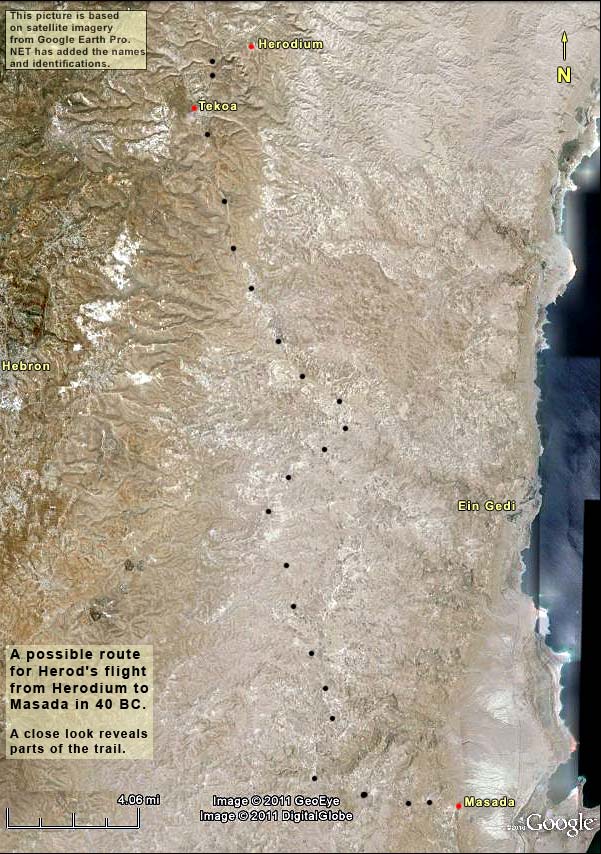
He would remember the day and the place. He would name the battle site after himself, build a palace on its hill, shape the hill into a mountain, and designate it for his burial. To round off the story: Unwilling to be held hostage against his brother, Phasael killed himself—it is said by bashing his head against the wall of his prison. Hyrcanus was delivered to Antigonus, who proceeded to cut or bite his ears off (a mutilated man cannot be High Priest). Herod left his family on Masada and, after an adventure with Cleopatra, reached Rome, where the triumvirate and the senate made him king of Judea. He returned, and now with solid Roman support, battled his way to power in 37 BC. Fifteen years or so later he sent builders to the hill that would become Herodium. {mospagebreak title=The site} The site Today's Herodium is at its most impressive from a distance. Close up we see bases, foundations, and the general forms of structures. The stone-weary tourist must exert an enormous act of imagination to picture the site as Herod would have known it, reconstructing the colonnades, repainting the frescoes, and putting gardens in place of the desert beige. (After the identity was forgotten, and long after beige had returned, the mountain was called in Arabic Furedis, meaning garden—we get the word "paradise" from it—although "Furedis" may also derive from the old "Herodium.") To help imagine the life that was lived here, we also have a few dozen graffiti which, on paleographic grounds, date back to Herodium's earliest period. E. Testa, who published them, writes as follows (Source)I translate from Othmar Keel, Max Kuechler and Christoph Uehlinger, Orte und Landschaften der Bibel, Koeln: Benziger and Goettingen: Vandenhoeck and Ruprecht, 1984. Volumes II. p. 653, but their source is Pubblicasioni dello Studium Biblicum Franciscanum, Jerusalem, Collectio Major 20/4, p. 107.: The palace-fortress was inhabited by an upper-class group. The writer of Ostracon 54 prides himself on his descent from noble ancestors; teachers are present here (No. 55), and court poets (No. 6), people who compose sarcastic poems (No. 49), people who live a luxurious, sensual life (Nos. 3, 9, 37, 45), easy women (No. 2) and gallant youth (Nos. 1, 36); individuals who are indeed far from Pharisaic casuistry, but who nonetheless observe the national rites (No. 62). They bought wine from Rhodes, glass from Sidon, and high-grade poison, a must for quick transitions in the royal courts of that age. Masturbation is praised (No. 3), as well as a visit to the "women's house" (No. 2). A certain Eutychios (No. 37) testifies to a "heart stirred up with excitement like a sand dune." Yet all we see before us is dull stone. The upper portion, a palace-fortress Originally, atop the natural hill, Herod erected two concentric circular walls 12 feet apart—we shall call this the encasement. It was 207 feet in diameter. The picture below has us standing on what remains of this encasement and looking down into the palace-villa, built on bedrock. You can see the inner encasement wall on the other side; increase its height to at least 60 feet, plaster it, and you have the original.
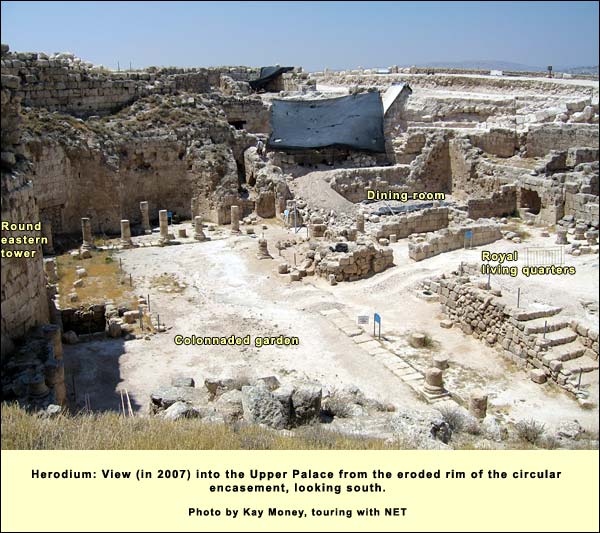
Between the concentric walls were seven stories of rooms. Only the upper stories had windows, so the lower would have served for storage. At the northern, western and southern compass points were semicircular towers, bulging from the encasement and perhaps rising slightly above it. Each was 45 feet across and likewise divided into stories with rooms. On the east Herod built a completely round tower 55 feet in diameter, whose remains today reach 50 feet above the inner floor. At their top, writes Netzer,Ehud Netzer, The Architecture of Herod, the Great Builder. Tuebingen: Mohr Siebeck, 2006, p. 186 is a barrel-vaulted cistern and two small rooms. He estimates that the original tower was 30 feet higher, 80 above the palace floor. This breezy perch would have dominated the desert, offering an unimpeded view toward the Dead Sea, Perea and Nabataea. As it looked from afar, therefore, Herodium did not resemble a volcano as it does today. This effect is the result of two further processes: (1) At some stage, perhaps not long before Herod's death in 4 BC, the top of the neighboring hill was lopped off and its dirt used to cover two-thirds of the encasement, giving Josephus the impression of a breast; (2) the remaining third collapsed, no doubt because of erosion and earthquake. It is remarkable that these factors did not destroy the artificial slope itself.
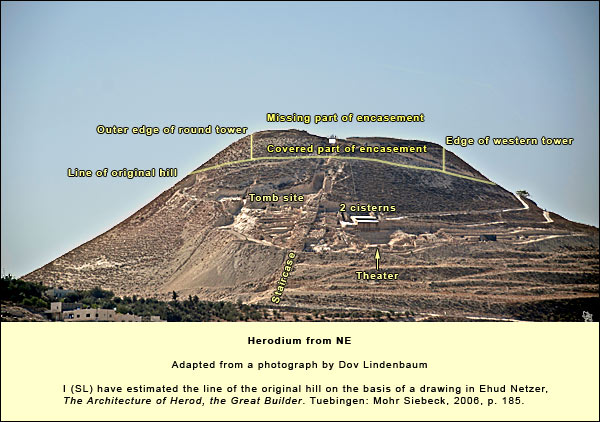
The inner, crater-like part of this upper palace-fortress was divided into two main sections (as can be seen in the second photo above). The eastern half was dominated by a rectangular courtyard, 130 feet long and 57 wide. It had colonnades on the north, west and south. On the east, however, a solid wall was used, with half-columns projecting out of it. The midpoint of this wall touched the circular tower. (If Herod had put a colonnade here, people would have seen how cramped the space was between the columns and the curved encasement.) V. Corbo, who excavated upper Herodium in the 1960's, found garden soil in this courtyard. The western half consisted of rooms. On the south was a dining room (45 feet by 30) in the form of a triclinium.Three benches or couches arranged in a U-shape formed the typical dining arrangement of aristocrats in the Roman period. On the north was a bathhouse. The dome of its tepidarium,A bathhouse typically had a dressing room (apodyterium), a cold room (frigidarium), a hot room (caldarium), and between the last two a lukewarm room (tepidarium) 14 feet across, is among the earliest extant domes of hewn stone. A window at the top, called an oculus, allowed light in. At the base we can still see traces of frescoes. Between the dining room and the bathhouse were the bedrooms and living quarters, some of which had two stories. Lower Herodium From the northern rim of the mountain we can look down at the lower portion, which Josephus hyped into a "city." It was in fact a grand affair, covering about 37 acres, but designed for the pleasures of one man and his entourage. Here Herod had his main palace, which he set precisely on an east-west axis. Built on fill that leveled the slope at this point, it was 427 feet long by 180 wide. If we extend the north-south axis of the upper palace, it precisely bisects the lower. (See the satellite photo below.) The same line goes on to bisect a narrow course, 1150 feet long, which ended at a monumental building on the west. Too narrow (82 feet) for a hippodrome, the course fits the description of Herod's funeral procession in Josephus (War I.33.9): There was a bier all of gold, embroidered with precious stones, and a purple bed of various contexture, with the dead body upon it, covered with purple; and a diadem was put upon his head, and a crown of gold above it, and a scepter in his right hand; and near to the bier were Herod's sons, and a multitude of his kindred; next to which came his guards, and the regiment of Thracians, the Germans. also and Gauls, all accounted as if they were going to war; but the rest of the army went foremost, armed, and following their captains and officers in a regular manner; after whom five hundred of his domestic servants and freed-men followed, with sweet spices in their hands: and the body was carried two hundred furlongs, to Herodium, where he had given order to be buried.
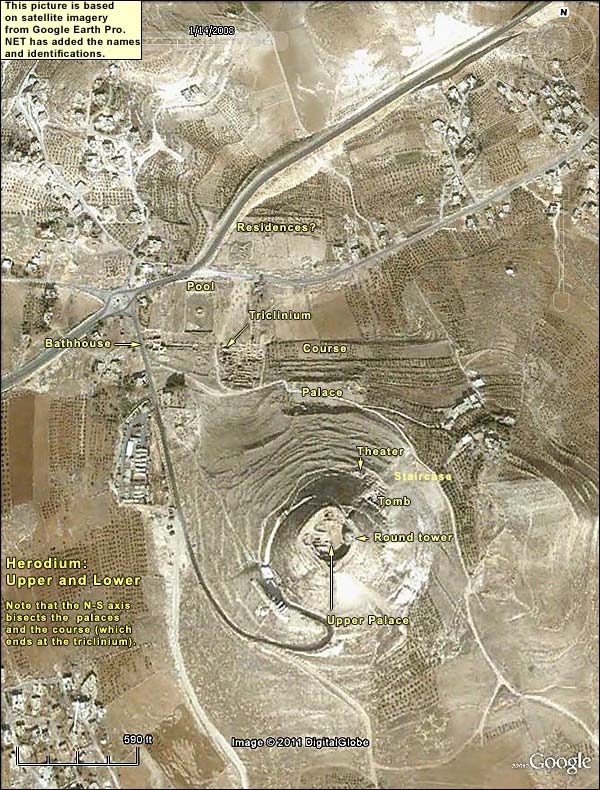
Netzer's inclination was to seek the tomb in or near the monumental building at the end of the course. It turned out to be a grand triclinium. Such are often found in connection with tombs (at Petra, for instance). They served for the funeral feast. Eagerly the archaeologists turned to neighboring structures. They found a ritual bath, which would also make sense if the tomb was here. And yet they found no tomb. Perhaps Herod originally planned to place it here but changed his mind.
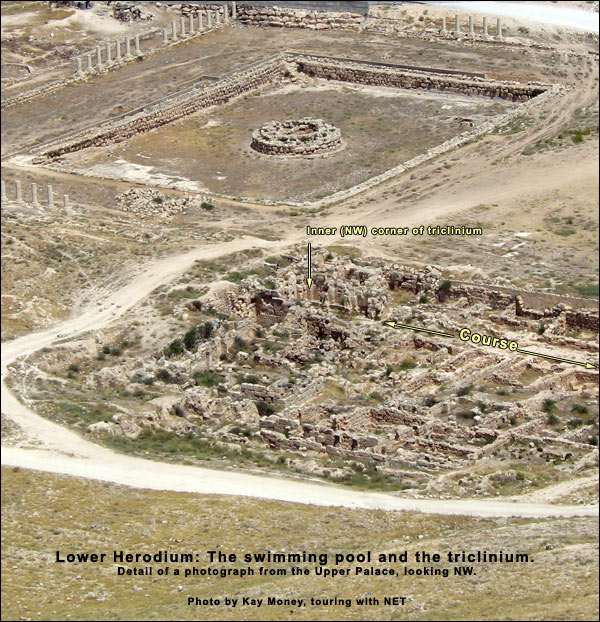
When we look from the northern rim of the upper palace, the most striking element is the swimming pool, pictured above. It is huge: 130 feet by 230 and 13 deep. In its center was a pillared pavilion where the swimmers could rest. (A French explorer sought the tomb on the pavilion in the 1860's.) The pool was fed by the aqueduct from the Artas spring. (Sections of this duct are still to be seen.) A garden surrounded the pool, as well as pillared promenades (some of the pillars have been restored). Columns also surrounded a large bathhouse SW of the pool. "The bathhouse was richly decorated. Its walls were adorned with frescoes which have been preserved in some of the rooms, and most of the rooms were originally paved with mosaics" (Netzer, op. cit., p. 192). In a later phase - but still during Herod's lifetime - the bathhouse was altered to accommodate a heated indoor pool. A round open-air pool was built nearby, and bathers could switch between the two. In the vicinity Netzer found "fragments of an exquisite water basin (labrum) made of imported marble, a characteristic example from the Augustan period, with the heads of the Greek demigod Selinus carved on its handles. Herod might have imported it; however, the high standard of this basin suggests that it was a royal gift, perhaps a personal one from Marcus Agrippa following his visit to Herod's kingdom in 15 B.C.E., which, according to Josephus, included a stay at Herodium" (Netzer, op. cit., p. 194). Yet the ban on graven images was interpreted very strictly in Herod's time. Perhaps he couldn't turn down a gift from his powerful friend, the heir-apparent to Augustus. Netzer thinks that the visit of Marcus Agrippa was also the occasion for building a theater, the most recent major discovery at Herodium. It was found in the slope just below the openings of two large cisterns. It seated 300 people, giving us an idea how many guests this desert retreat was intended for. Netzer discovered the royal "box" (loggia), really a large room for the king and his guests, from which they could watch the performance (it was 26 feet long by 23 wide and 20 high). On its walls are remains of paintings representing windows. As if through one window appears a landscape with animals and humans. As if through another is what seems to be a sea battle. Another painting, deft and delicate, shows the billowing sail and rigging of a ship, on which soldiers are massed with spears and shields. This may have served as a conversation piece during the visit of Agrippa, whose greatest victory was the sea battle at Actium in 31 BC, which secured the throne for his friend Octavian (later called Augustus). Here too, then, the ban on images was violated. The style, quite foreign, is known from Rome and Pompeii, so it is thought to be the work of Italian artists sent by Agrippa. After deciding to build his tomb not far from the theater, Herod had this big "box" destroyed (slicing it on the diagonal to suit the shape he wanted), as well as everything else in the vicinity: theater, villas, and storehouses. He then brought in dirt from the neighboring hill, which he flattened, and poured it over the levelled structures, creating the slope that gives Herodium its present conical shape. He built the tomb on the side facing Jerusalem so that it would stand out in relief against the smooth slope. His revels now were ended.
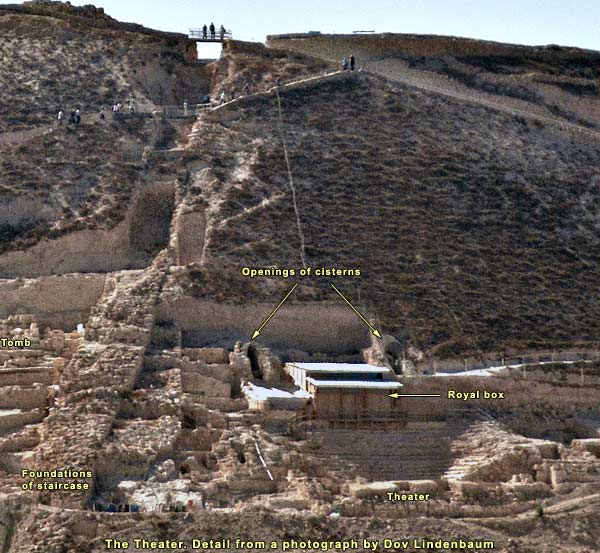
The cisterns In addition to covering the theater, Herod also eliminated a cistern in order to build his mausoleum. In 1975 Netzer descended through tunnels from the upper palace to reach this cistern, which he proceeded to explore. At one point he was 10 feet from the tomb that it would take him another 32 years to find. Two more large cisterns are located a few yards to the west and a bit lower (contrary to a sign at the site, they are midway up the mountain, not at its foot). The total capacity is 2500 cubic meters (1 cubic meter = 1000 liters). Netzer thought that their main source was runoff from the slope above, but then as now Herodium was on the edge of the desert, and it seems unlikely that local rainfall would have sufficed. An alternative view would be that the water was hauled from lower Herodium, which received it via the duct from Artas. Herod would have needed a place to store this water, and the three cisterns appear to be the only such facility. Given Roman technology, it would not have been a problem to haul water this high mechanically. According to need, slaves could have then borne it from the cisterns to a spot just below the upper encasement. Here a pipe (extant) led to an intermediate cistern, from which the water could then be lifted by rope and bucket into the palace. In this way the sweating slaves wouldn't stink up the royal quarter. The location of the cisterns, determined by the quality of the rock, probably decided the placement of the external staircase. Josephus saw 200 white "marble" steps (but he often called limestone "marble"); today we see just the foundation. The staircase is puzzling, however, because the upper part is clearly late: it is built right over a terraced garden, which it nullified. Perhaps the staircase was preceded by a less majestic access, before the hill became a mountain. Today we can descend from the upper palace to the cisterns using tunnels hewn by Jewish rebels during the Bar Kokhba revolt (ca. 130-135 AD). The rebels dumped the debris from their chiseling into the cisterns, putting them out of use. (If the cisterns had gathered most of their water from the slopes, the rebels would certainly have maintained them.) The purpose of these tunnels is not clear, but we know that the Bar Kokhba rebels dug thousands in the Shephelah, and some around Hebron. The general idea, it is thought, was to emerge in surprise attacks on the Romans and disappear again into the earth. At Herodium, the tunnels may also have provided secret escape routes.
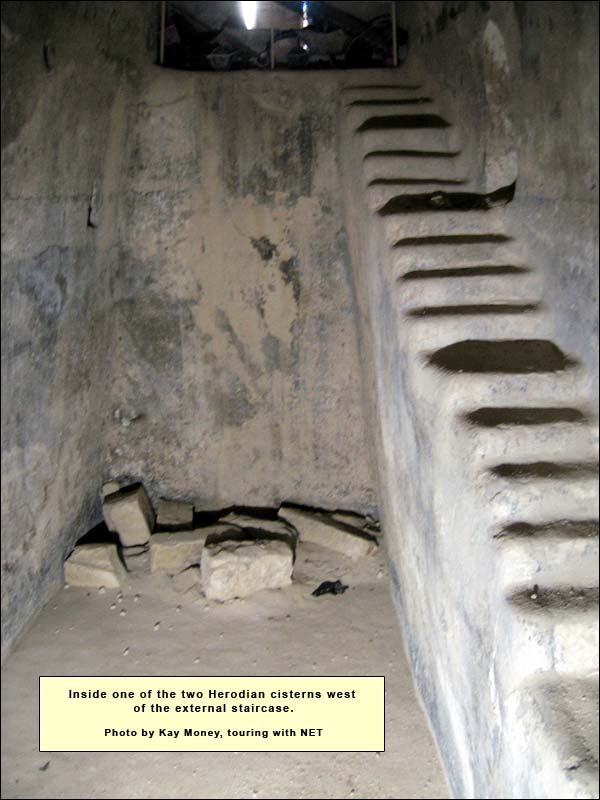
{mospagebreak title=The tomb} The tomb

Before 1967, Herodium was under Jordanian rule, and the chief archaeologist was V. Corbo. Clearing the area around the mouth of a cistern, he exposed part of "a grand stone wall leaning on the hillside" (Kreiger).Barbara Kreiger, In Search of Herod's Tomb, New Word City, 2011, Kindle Edition, Locations 159-165 Netzer, who began here in 1972, made note of Corbo's wall but did not pursue it. His interest was not just in the tomb, of course, but in the careful, patient exposure of the whole architectural complex. Nevertheless, the riddle was ever there, prodding. I worked under Netzer in 1982, and the question always hovered above us. Josephus had written that Herod was buried here. Why then had nothing turned up? Netzer ruled out the upper palace where Corbo had concentrated, because in that small space the tomb would have rendered all residents—including Herod's successor—corpse-impure (hence ineligible for entering the Temple in Jerusalem). The sole alternative, he thought, was the larger space of lower Herodium. Only after exhausting the possibilities there did Netzer decide to explore the area on the slope around Corbo's wall. It was April 2007. He wasn't at the site when the first hint came. He got a phone call from his assistant, saying that something monumental was turning up. That, Netzer said, was his "Aha!" moment. First, here is a detail from Ferrell Jenkins' aerial photo:
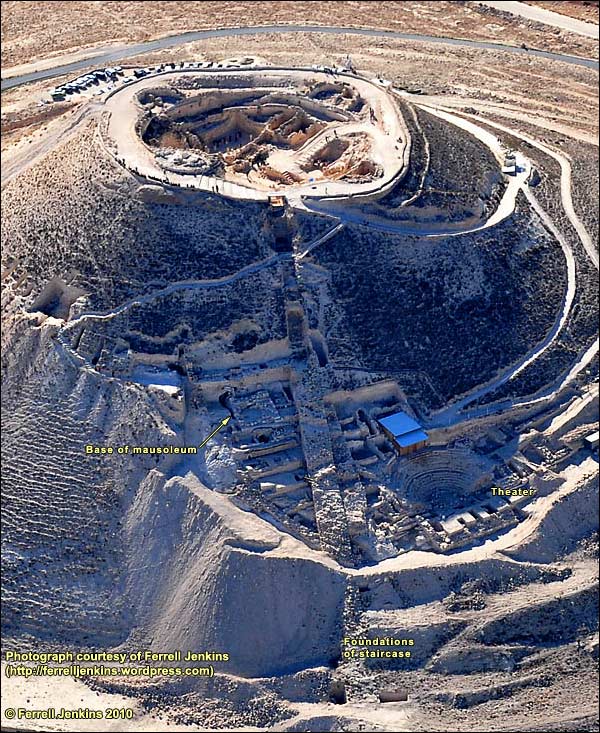
And now this from a surface shot by Dov Lindenbaum:
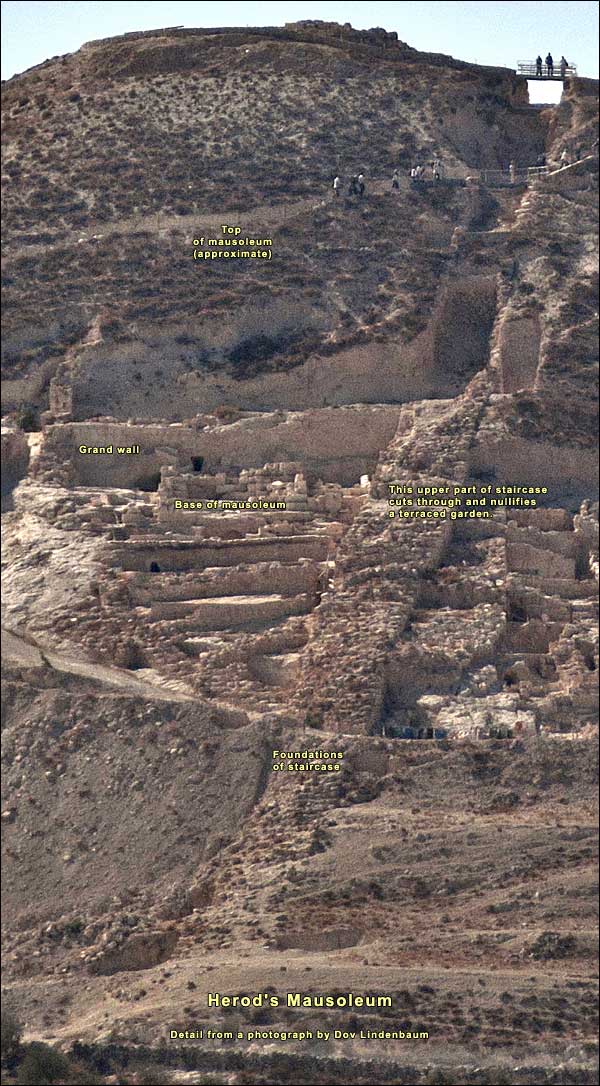
Below the leaning stone wall, Netzer and his team found the southern part of the podium:
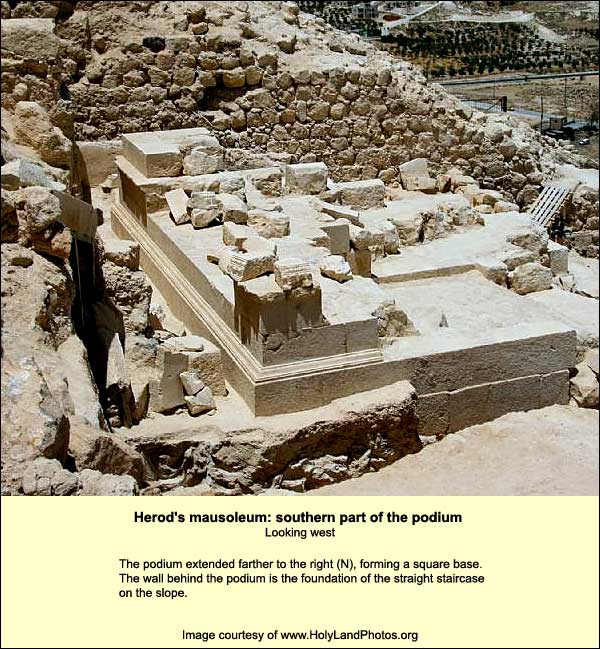
The mausolem was made of the best limestone—called meleke in Arabic, "royal"—imported from the peak of the central mountain range a mile away. (This is the only use of meleke at Herodium.) The two southern corners of the podium enabled Netzer to put its outermost dimensions at 30 feet by 30, enough to support a structure 70 feet high. Judging from the extant pieces, and with the help of his assistant, Rachel Chachy, he was able to give the following description: "The podium served as the base of a vaulted room about 20 by 20 feet. Its outer walls probably featured pilasters (rectangular column-like protrusions). These bore a Doric frieze with rosettes, topped by a decorated cornice. Above this stood a circular room (about 14 ft in diameter and 17 ft high) surrounded by a portico of 18 monolithic columns. The columns supported a round entablature composed of an architrave, a soffit frieze and a highly decorated cornice …. This room was probably covered by a dome, in contrast to the barrel-vaulted ceilings of the two rooms below." (Source.Ehud Netzer, "In Search of Herod's Tomb," Biblical Archaeology Review, 37:01, January/February 2011.)
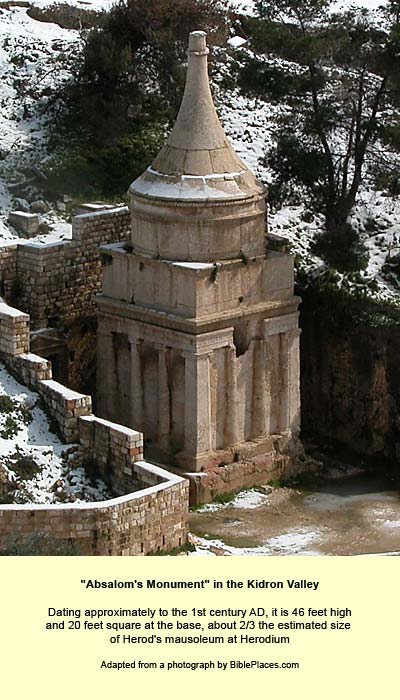
The dome, Netzer continues, was curved and conical. Compare the dome of a nearly contemporary tomb monument in Jerusalem, misnamed Absalom's Memorial, which is about half the size. Its meleke has been deeply weathered, in contrast with the stones from Herod's mausoleum, which have no patina. Netzer thinks that the uppermost, domed room contained the sarcophagus. The outside was adorned with four funerary urns, while a fifth urn probably crowned its top. After building the mausoleum and putting a garden around it, Herod raised the grand wall above it to hold back the fill that he intended to pour. Only then did he raise the hill, shaping it into the mountain we see today, so that his mausoleum would stand out against it. There is, as said, no patina on the stones of the tomb. The chisel marks appear so fresh that they could not have been long exposed to the elements. Chachy suggests 50 or 60 years, which would more or less fit the timing of the great revolt. The Jewish rebels, who hated the memory of Herod, did not want him affronting their eyes when they looked toward the desert. It was they, probably, who destroyed the mausoleum. Soon the pieces were covered in debris and dust. In the area of the mausoleum the excavators found hundreds of fragments of reddish stone. When Chachy put what she had together, these formed parts of a beautifully carved sarcophagus. Even the rich, said Netzer, did not have one like this. He thinks it was Herod's. Why the tiny fragments strewn about? Perhaps the rebels knew whose remains it contained and smashed it to bits. Pieces of two more sarcophagi, white in color, were also discovered: they had been unceremoniously dumped and their pieces were closer together. They could have belonged to family members of Herod's son Archelaus, his successor in Judea. A few fragments of bone were found as well, but they have so far yielded nothing. Was this, then, Herod's tomb? Netzer put his certainty at 98 percent. Everything adds up: the statement in Josephus, the imported meleke, the elimination of a cistern and a theater, the sloped stone wall, the grand red sarcophagus chopped to bits, the exhaustion of other alternatives. He would have liked, however, to find an inscription. {mospagebreak title=Later history} The later history
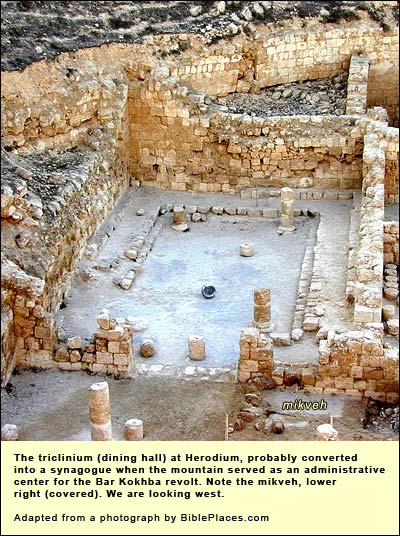
After the fall of Jerusalem, Josephus tells us, the surviving free rebels took refuge in Herodium, Machaerus and Masada. In 71 or 72, a new Roman legate named Bassus "secured the submission of the fortress of Herodium together with its defenders" (War VII 6.1). The water supply was probably decisive: holding the aqueduct from the Artas spring, the Romans could maintain a siege for as long as it took, and there was no one to whom the rebels could send for help. According to Netzer, they dug a tunnel to Herod's cisterns from above, but it was mostly obliterated by the tunneling of the next group of rebels, to whom we turn now. In a cave at Wadi Murabat above the Dead Sea, rental contractsDiscoveries in the Judaean Desert, Oxford Univ. Press, II pp. 122-134, cited in Othmar Keel, Max Kuechler and Christoph Uehlinger, Orte und Landschaften der Bibel, Koeln: Benziger and Goettingen: Vandenhoeck and Ruprecht, 1984. Volume II, p. 656. were discovered mentioning Herodium as an administrative center during the Bar Kokhba Revolt (ca. 130-135 AD). The contracts call Herodium "Herodis" (whence perhaps the Arabic Furedis). About a thousand bronze coins minted under Bar Kokhba turned up near the upper palace's southern tower: perhaps the center's treasury. The relatively dense population of rebels in the small space above would account for the many rather simple foundations of walls that Corbo found: they partitioned the area into small rooms. In Herod's colonnaded courtyard the rebels erected a large lime kiln. Just outside the entrance to the old dining room they made a ritual bath (mikveh). They probably converted the dining room itself into a synagogue with benches on the sides. At the western end of the double encasement wall, the building stones are displaced and there are traces of fire—perhaps signs of their final battle in 135. From the Byzantine period, numerous Christian symbols appear in upper Herodium. The rich monastic literature, however, mentions no monastery here. Joe Zias,Joseph Zias, "Was Byzantine Herodium a Leprosarium?" Biblical Archaeologist, Sept. 1986has argued the case for identifying Herodium with an unlocated site named "the Phordisia" (whence Furedis?), where the beautiful Byzantine Empress Eudocia, around 438 AD, founded a hospital for 400 lepers. {mospagebreak title=Logistics} Logistics Phones: 050-623-5821 (at site); 057-776-2251; 057-776-1143; Nature Reserves and National Parks (Main office: 02/500-5444) Opening hours: April 1 through September 30, from 8.00 - 17.00. (Entrance until 16.00)* October 1 through March 31, from 8.00 - 16.00. (Entrance until 15.00)* *On Fridays and the eves of Jewish holidays, the sites close one hour earlier. For example, on a Friday in March one must enter by 14.00 and leave by 15.00.

Herod had a deeper motive still for his intensive building activities, though not necessarily a conscious one. For when we read his story in JosephusJosephus Flavius (36-100 AD), Jewish general, one of two directing the revolt against Rome in Galilee. After Vespasian captured him, he prophesied the latter would be emperor. When this proved true, the Romans honored him. He then turned historian, writing The Jewish War, The Antiquities of the Jews and many other books. Because of a paragraph about John the Baptist and a sentence about Jesus, the Church preserved his works. (who used a multivolume biography written by a courtier, Nicholas of Damascus), we see a man of enormous energy, fighting battle after battle in his quest for power. When finally he did achieve the throne, and especially after the Pax Romana set in (under Augustus in the 20's BC), what was Herod to do with all his energy? He poured it into building. Even that wasn't enough, however. The remainder curdled into paranoia. But why did Herod choose precisely this spot to imprint himself? We can omit at once any reference to strategic ends. The only threats from the desert would have been in the form of Bedouin raids—hardly enough to justify a stupendous project like Herodium. Ehud Netzer,Ehud Netzer, The Architecture of Herod, the Great Builder. Tuebingen: Mohr Siebeck, 2006, p. 181 the chief archaeologist here for 38 years, abstained from listing Herodium among the desert fortresses. Besides, apart from the lack of strategic value, its water was too easily interrupted: it came through an aqueduct from the Artas spring three miles away at Solomon's Pools. The local rainfall would not have sufficed. When Jewish rebels tried to use Herodium as a refuge after the destruction of the Temple in 70 AD, they could not hold out. To judge from the structures above and below, during Herod's lifetime the place served as a recreational complex near the capital—a kind of Camp David. And, as said, he appointed it to be the site of his tomb, turning the whole hill into a monument. We can best understand his choice of this spot if we go back to an event that occurred here during his struggle for power. But to understand the event, we need a little historical background, which is only to be found in Josephus. The story The Hasmoneans, after fighting for 26 years, led the Jewish people to independence in 141 BC. They ruled, often cruelly, until the late 60's BC, when two Hasmonean brothers got into a quarrel about which of them should be king/high priest. In 63, both sought help from the Roman general, Pompey, who had recently arrived in Syria. Pompey decided in favor of the older, Hyrcanus II, because the younger, Aristobulus II, struck him as rather too arrogant. Aristobulus rebelled against this decision, and Pompey had to enter the land to enforce it. After taking most of Jerusalem without a battle, he besieged the Temple for three months, building siege ramps on Sabbath, when the Jews would not resist (a hint, perhaps, as to how the Romans later managed to build the ramp at Masada). When at last he took the Temple, slaughtering many, he entered the Holy of Holies for a look. This was a major violation: only the High Priest was permitted to enter the Holy of Holies. The Jews would never forgive him. Pompey reinstated Hyrcanus as high priest, although Aristobulus and his sons occasionally mounted rebellions. Josephus portrays Hyrcanus as a weak character (although he may have been the "Wicked Priest"Michael Wise, Martin Abegg Jr., and Edward Cook, The Dead Sea Scrolls: A New Translation, New York: HarperCollins, 2005, p. 31 of the Dead Sea Scrolls). At his right hand, however, he had a crafty, strong and energetic advisor named Antipater, an Idumean whose father had converted to Judaism under compulsion. This Antipater was the father of two sons: Phasael and Herod. In the wider Roman realm, in 49, civil war broke out between Pompey and another successful general, Julius Caesar. A year later Pompey was defeated. Now Hyrcanus and Antipater swung over to Caesar's party. The former was reconfirmed as high priest and received the title of ethnarch. Antipater became procurator of Judea. His son Phasael was charged with the rule of Judea and Perea, Herod with that of Galilee. On this basis they were able to maintain small armies. In 44 Caesar was assassinated, and a year later, so was Antipater. A son of Aristobulus, called Antigonus, tried again to unseat Hyrcanus, but in vain. In 40 came a reversal. Rome's inveterate enemy in the East, the Parthians, invaded its provinces here. This posed a major threat, because Rome was the world's biggest city in population (a few decades later its grain consumption would amount to 300,000 tons per year) and ships bearing grain from Egypt required safe harborage on the coast. Antigonus allied himself with the Parthians, promising much money and many women in return for deposing Hyrcanus and giving him the Jewish throne. The Parthian general took the bribe and swept down on Jerusalem. Because of his anti-Roman stance, Antigonus got support from Jewish pilgrims, who were coming in for the Feast of Weeks. They and the Parthians held the temple and much of the city, while Herod and Phasael held the palace on the western hill (near the Jaffa Gate) and part of the wall. It was a stalemate. But then, writes Josephus, Phasael and Hyrcanus were lured into Galilee under the pretext of negotiations—and imprisoned. Before his confinement, however, Phasael was able to send a note to his brother in Jerusalem. Realizing the hopeless position, Herod gathered his family and fled the city, accompanied by a band of soldiers. His aim was to reach Masada, a natural fortress. Soon into the journey, however, his mother, Kypros, was thrown from her chariot. Thinking her dead and knowing that his enemies would soon catch up, Herod drew his sword and pointed it toward his belly. His companions grabbed him. They accused him of cowardice: would he leave them to the mercies of their foes? In the midst of this commotion, Kypros regained consciousness and the escape continued. Eight miles south of Jerusalem, however, a force of Jews attacked. Against the odds, Herod won. He and his family then continued undisturbed to Masada.

He would remember the day and the place. He would name the battle site after himself, build a palace on its hill, shape the hill into a mountain, and designate it for his burial. To round off the story: Unwilling to be held hostage against his brother, Phasael killed himself—it is said by bashing his head against the wall of his prison. Hyrcanus was delivered to Antigonus, who proceeded to cut or bite his ears off (a mutilated man cannot be High Priest). Herod left his family on Masada and, after an adventure with Cleopatra, reached Rome, where the triumvirate and the senate made him king of Judea. He returned, and now with solid Roman support, battled his way to power in 37 BC. Fifteen years or so later he sent builders to the hill that would become Herodium. {mospagebreak title=The site} The site Today's Herodium is at its most impressive from a distance. Close up we see bases, foundations, and the general forms of structures. The stone-weary tourist must exert an enormous act of imagination to picture the site as Herod would have known it, reconstructing the colonnades, repainting the frescoes, and putting gardens in place of the desert beige. (After the identity was forgotten, and long after beige had returned, the mountain was called in Arabic Furedis, meaning garden—we get the word "paradise" from it—although "Furedis" may also derive from the old "Herodium.") To help imagine the life that was lived here, we also have a few dozen graffiti which, on paleographic grounds, date back to Herodium's earliest period. E. Testa, who published them, writes as follows (Source)I translate from Othmar Keel, Max Kuechler and Christoph Uehlinger, Orte und Landschaften der Bibel, Koeln: Benziger and Goettingen: Vandenhoeck and Ruprecht, 1984. Volumes II. p. 653, but their source is Pubblicasioni dello Studium Biblicum Franciscanum, Jerusalem, Collectio Major 20/4, p. 107.: The palace-fortress was inhabited by an upper-class group. The writer of Ostracon 54 prides himself on his descent from noble ancestors; teachers are present here (No. 55), and court poets (No. 6), people who compose sarcastic poems (No. 49), people who live a luxurious, sensual life (Nos. 3, 9, 37, 45), easy women (No. 2) and gallant youth (Nos. 1, 36); individuals who are indeed far from Pharisaic casuistry, but who nonetheless observe the national rites (No. 62). They bought wine from Rhodes, glass from Sidon, and high-grade poison, a must for quick transitions in the royal courts of that age. Masturbation is praised (No. 3), as well as a visit to the "women's house" (No. 2). A certain Eutychios (No. 37) testifies to a "heart stirred up with excitement like a sand dune." Yet all we see before us is dull stone. The upper portion, a palace-fortress Originally, atop the natural hill, Herod erected two concentric circular walls 12 feet apart—we shall call this the encasement. It was 207 feet in diameter. The picture below has us standing on what remains of this encasement and looking down into the palace-villa, built on bedrock. You can see the inner encasement wall on the other side; increase its height to at least 60 feet, plaster it, and you have the original.

Between the concentric walls were seven stories of rooms. Only the upper stories had windows, so the lower would have served for storage. At the northern, western and southern compass points were semicircular towers, bulging from the encasement and perhaps rising slightly above it. Each was 45 feet across and likewise divided into stories with rooms. On the east Herod built a completely round tower 55 feet in diameter, whose remains today reach 50 feet above the inner floor. At their top, writes Netzer,Ehud Netzer, The Architecture of Herod, the Great Builder. Tuebingen: Mohr Siebeck, 2006, p. 186 is a barrel-vaulted cistern and two small rooms. He estimates that the original tower was 30 feet higher, 80 above the palace floor. This breezy perch would have dominated the desert, offering an unimpeded view toward the Dead Sea, Perea and Nabataea. As it looked from afar, therefore, Herodium did not resemble a volcano as it does today. This effect is the result of two further processes: (1) At some stage, perhaps not long before Herod's death in 4 BC, the top of the neighboring hill was lopped off and its dirt used to cover two-thirds of the encasement, giving Josephus the impression of a breast; (2) the remaining third collapsed, no doubt because of erosion and earthquake. It is remarkable that these factors did not destroy the artificial slope itself.

The inner, crater-like part of this upper palace-fortress was divided into two main sections (as can be seen in the second photo above). The eastern half was dominated by a rectangular courtyard, 130 feet long and 57 wide. It had colonnades on the north, west and south. On the east, however, a solid wall was used, with half-columns projecting out of it. The midpoint of this wall touched the circular tower. (If Herod had put a colonnade here, people would have seen how cramped the space was between the columns and the curved encasement.) V. Corbo, who excavated upper Herodium in the 1960's, found garden soil in this courtyard. The western half consisted of rooms. On the south was a dining room (45 feet by 30) in the form of a triclinium.Three benches or couches arranged in a U-shape formed the typical dining arrangement of aristocrats in the Roman period. On the north was a bathhouse. The dome of its tepidarium,A bathhouse typically had a dressing room (apodyterium), a cold room (frigidarium), a hot room (caldarium), and between the last two a lukewarm room (tepidarium) 14 feet across, is among the earliest extant domes of hewn stone. A window at the top, called an oculus, allowed light in. At the base we can still see traces of frescoes. Between the dining room and the bathhouse were the bedrooms and living quarters, some of which had two stories. Lower Herodium From the northern rim of the mountain we can look down at the lower portion, which Josephus hyped into a "city." It was in fact a grand affair, covering about 37 acres, but designed for the pleasures of one man and his entourage. Here Herod had his main palace, which he set precisely on an east-west axis. Built on fill that leveled the slope at this point, it was 427 feet long by 180 wide. If we extend the north-south axis of the upper palace, it precisely bisects the lower. (See the satellite photo below.) The same line goes on to bisect a narrow course, 1150 feet long, which ended at a monumental building on the west. Too narrow (82 feet) for a hippodrome, the course fits the description of Herod's funeral procession in Josephus (War I.33.9): There was a bier all of gold, embroidered with precious stones, and a purple bed of various contexture, with the dead body upon it, covered with purple; and a diadem was put upon his head, and a crown of gold above it, and a scepter in his right hand; and near to the bier were Herod's sons, and a multitude of his kindred; next to which came his guards, and the regiment of Thracians, the Germans. also and Gauls, all accounted as if they were going to war; but the rest of the army went foremost, armed, and following their captains and officers in a regular manner; after whom five hundred of his domestic servants and freed-men followed, with sweet spices in their hands: and the body was carried two hundred furlongs, to Herodium, where he had given order to be buried.

Netzer's inclination was to seek the tomb in or near the monumental building at the end of the course. It turned out to be a grand triclinium. Such are often found in connection with tombs (at Petra, for instance). They served for the funeral feast. Eagerly the archaeologists turned to neighboring structures. They found a ritual bath, which would also make sense if the tomb was here. And yet they found no tomb. Perhaps Herod originally planned to place it here but changed his mind.

When we look from the northern rim of the upper palace, the most striking element is the swimming pool, pictured above. It is huge: 130 feet by 230 and 13 deep. In its center was a pillared pavilion where the swimmers could rest. (A French explorer sought the tomb on the pavilion in the 1860's.) The pool was fed by the aqueduct from the Artas spring. (Sections of this duct are still to be seen.) A garden surrounded the pool, as well as pillared promenades (some of the pillars have been restored). Columns also surrounded a large bathhouse SW of the pool. "The bathhouse was richly decorated. Its walls were adorned with frescoes which have been preserved in some of the rooms, and most of the rooms were originally paved with mosaics" (Netzer, op. cit., p. 192). In a later phase - but still during Herod's lifetime - the bathhouse was altered to accommodate a heated indoor pool. A round open-air pool was built nearby, and bathers could switch between the two. In the vicinity Netzer found "fragments of an exquisite water basin (labrum) made of imported marble, a characteristic example from the Augustan period, with the heads of the Greek demigod Selinus carved on its handles. Herod might have imported it; however, the high standard of this basin suggests that it was a royal gift, perhaps a personal one from Marcus Agrippa following his visit to Herod's kingdom in 15 B.C.E., which, according to Josephus, included a stay at Herodium" (Netzer, op. cit., p. 194). Yet the ban on graven images was interpreted very strictly in Herod's time. Perhaps he couldn't turn down a gift from his powerful friend, the heir-apparent to Augustus. Netzer thinks that the visit of Marcus Agrippa was also the occasion for building a theater, the most recent major discovery at Herodium. It was found in the slope just below the openings of two large cisterns. It seated 300 people, giving us an idea how many guests this desert retreat was intended for. Netzer discovered the royal "box" (loggia), really a large room for the king and his guests, from which they could watch the performance (it was 26 feet long by 23 wide and 20 high). On its walls are remains of paintings representing windows. As if through one window appears a landscape with animals and humans. As if through another is what seems to be a sea battle. Another painting, deft and delicate, shows the billowing sail and rigging of a ship, on which soldiers are massed with spears and shields. This may have served as a conversation piece during the visit of Agrippa, whose greatest victory was the sea battle at Actium in 31 BC, which secured the throne for his friend Octavian (later called Augustus). Here too, then, the ban on images was violated. The style, quite foreign, is known from Rome and Pompeii, so it is thought to be the work of Italian artists sent by Agrippa. After deciding to build his tomb not far from the theater, Herod had this big "box" destroyed (slicing it on the diagonal to suit the shape he wanted), as well as everything else in the vicinity: theater, villas, and storehouses. He then brought in dirt from the neighboring hill, which he flattened, and poured it over the levelled structures, creating the slope that gives Herodium its present conical shape. He built the tomb on the side facing Jerusalem so that it would stand out in relief against the smooth slope. His revels now were ended.

The cisterns In addition to covering the theater, Herod also eliminated a cistern in order to build his mausoleum. In 1975 Netzer descended through tunnels from the upper palace to reach this cistern, which he proceeded to explore. At one point he was 10 feet from the tomb that it would take him another 32 years to find. Two more large cisterns are located a few yards to the west and a bit lower (contrary to a sign at the site, they are midway up the mountain, not at its foot). The total capacity is 2500 cubic meters (1 cubic meter = 1000 liters). Netzer thought that their main source was runoff from the slope above, but then as now Herodium was on the edge of the desert, and it seems unlikely that local rainfall would have sufficed. An alternative view would be that the water was hauled from lower Herodium, which received it via the duct from Artas. Herod would have needed a place to store this water, and the three cisterns appear to be the only such facility. Given Roman technology, it would not have been a problem to haul water this high mechanically. According to need, slaves could have then borne it from the cisterns to a spot just below the upper encasement. Here a pipe (extant) led to an intermediate cistern, from which the water could then be lifted by rope and bucket into the palace. In this way the sweating slaves wouldn't stink up the royal quarter. The location of the cisterns, determined by the quality of the rock, probably decided the placement of the external staircase. Josephus saw 200 white "marble" steps (but he often called limestone "marble"); today we see just the foundation. The staircase is puzzling, however, because the upper part is clearly late: it is built right over a terraced garden, which it nullified. Perhaps the staircase was preceded by a less majestic access, before the hill became a mountain. Today we can descend from the upper palace to the cisterns using tunnels hewn by Jewish rebels during the Bar Kokhba revolt (ca. 130-135 AD). The rebels dumped the debris from their chiseling into the cisterns, putting them out of use. (If the cisterns had gathered most of their water from the slopes, the rebels would certainly have maintained them.) The purpose of these tunnels is not clear, but we know that the Bar Kokhba rebels dug thousands in the Shephelah, and some around Hebron. The general idea, it is thought, was to emerge in surprise attacks on the Romans and disappear again into the earth. At Herodium, the tunnels may also have provided secret escape routes.

{mospagebreak title=The tomb} The tomb

Before 1967, Herodium was under Jordanian rule, and the chief archaeologist was V. Corbo. Clearing the area around the mouth of a cistern, he exposed part of "a grand stone wall leaning on the hillside" (Kreiger).Barbara Kreiger, In Search of Herod's Tomb, New Word City, 2011, Kindle Edition, Locations 159-165 Netzer, who began here in 1972, made note of Corbo's wall but did not pursue it. His interest was not just in the tomb, of course, but in the careful, patient exposure of the whole architectural complex. Nevertheless, the riddle was ever there, prodding. I worked under Netzer in 1982, and the question always hovered above us. Josephus had written that Herod was buried here. Why then had nothing turned up? Netzer ruled out the upper palace where Corbo had concentrated, because in that small space the tomb would have rendered all residents—including Herod's successor—corpse-impure (hence ineligible for entering the Temple in Jerusalem). The sole alternative, he thought, was the larger space of lower Herodium. Only after exhausting the possibilities there did Netzer decide to explore the area on the slope around Corbo's wall. It was April 2007. He wasn't at the site when the first hint came. He got a phone call from his assistant, saying that something monumental was turning up. That, Netzer said, was his "Aha!" moment. First, here is a detail from Ferrell Jenkins' aerial photo:

And now this from a surface shot by Dov Lindenbaum:

Below the leaning stone wall, Netzer and his team found the southern part of the podium:

The mausolem was made of the best limestone—called meleke in Arabic, "royal"—imported from the peak of the central mountain range a mile away. (This is the only use of meleke at Herodium.) The two southern corners of the podium enabled Netzer to put its outermost dimensions at 30 feet by 30, enough to support a structure 70 feet high. Judging from the extant pieces, and with the help of his assistant, Rachel Chachy, he was able to give the following description: "The podium served as the base of a vaulted room about 20 by 20 feet. Its outer walls probably featured pilasters (rectangular column-like protrusions). These bore a Doric frieze with rosettes, topped by a decorated cornice. Above this stood a circular room (about 14 ft in diameter and 17 ft high) surrounded by a portico of 18 monolithic columns. The columns supported a round entablature composed of an architrave, a soffit frieze and a highly decorated cornice …. This room was probably covered by a dome, in contrast to the barrel-vaulted ceilings of the two rooms below." (Source.Ehud Netzer, "In Search of Herod's Tomb," Biblical Archaeology Review, 37:01, January/February 2011.)

The dome, Netzer continues, was curved and conical. Compare the dome of a nearly contemporary tomb monument in Jerusalem, misnamed Absalom's Memorial, which is about half the size. Its meleke has been deeply weathered, in contrast with the stones from Herod's mausoleum, which have no patina. Netzer thinks that the uppermost, domed room contained the sarcophagus. The outside was adorned with four funerary urns, while a fifth urn probably crowned its top. After building the mausoleum and putting a garden around it, Herod raised the grand wall above it to hold back the fill that he intended to pour. Only then did he raise the hill, shaping it into the mountain we see today, so that his mausoleum would stand out against it. There is, as said, no patina on the stones of the tomb. The chisel marks appear so fresh that they could not have been long exposed to the elements. Chachy suggests 50 or 60 years, which would more or less fit the timing of the great revolt. The Jewish rebels, who hated the memory of Herod, did not want him affronting their eyes when they looked toward the desert. It was they, probably, who destroyed the mausoleum. Soon the pieces were covered in debris and dust. In the area of the mausoleum the excavators found hundreds of fragments of reddish stone. When Chachy put what she had together, these formed parts of a beautifully carved sarcophagus. Even the rich, said Netzer, did not have one like this. He thinks it was Herod's. Why the tiny fragments strewn about? Perhaps the rebels knew whose remains it contained and smashed it to bits. Pieces of two more sarcophagi, white in color, were also discovered: they had been unceremoniously dumped and their pieces were closer together. They could have belonged to family members of Herod's son Archelaus, his successor in Judea. A few fragments of bone were found as well, but they have so far yielded nothing. Was this, then, Herod's tomb? Netzer put his certainty at 98 percent. Everything adds up: the statement in Josephus, the imported meleke, the elimination of a cistern and a theater, the sloped stone wall, the grand red sarcophagus chopped to bits, the exhaustion of other alternatives. He would have liked, however, to find an inscription. {mospagebreak title=Later history} The later history

After the fall of Jerusalem, Josephus tells us, the surviving free rebels took refuge in Herodium, Machaerus and Masada. In 71 or 72, a new Roman legate named Bassus "secured the submission of the fortress of Herodium together with its defenders" (War VII 6.1). The water supply was probably decisive: holding the aqueduct from the Artas spring, the Romans could maintain a siege for as long as it took, and there was no one to whom the rebels could send for help. According to Netzer, they dug a tunnel to Herod's cisterns from above, but it was mostly obliterated by the tunneling of the next group of rebels, to whom we turn now. In a cave at Wadi Murabat above the Dead Sea, rental contractsDiscoveries in the Judaean Desert, Oxford Univ. Press, II pp. 122-134, cited in Othmar Keel, Max Kuechler and Christoph Uehlinger, Orte und Landschaften der Bibel, Koeln: Benziger and Goettingen: Vandenhoeck and Ruprecht, 1984. Volume II, p. 656. were discovered mentioning Herodium as an administrative center during the Bar Kokhba Revolt (ca. 130-135 AD). The contracts call Herodium "Herodis" (whence perhaps the Arabic Furedis). About a thousand bronze coins minted under Bar Kokhba turned up near the upper palace's southern tower: perhaps the center's treasury. The relatively dense population of rebels in the small space above would account for the many rather simple foundations of walls that Corbo found: they partitioned the area into small rooms. In Herod's colonnaded courtyard the rebels erected a large lime kiln. Just outside the entrance to the old dining room they made a ritual bath (mikveh). They probably converted the dining room itself into a synagogue with benches on the sides. At the western end of the double encasement wall, the building stones are displaced and there are traces of fire—perhaps signs of their final battle in 135. From the Byzantine period, numerous Christian symbols appear in upper Herodium. The rich monastic literature, however, mentions no monastery here. Joe Zias,Joseph Zias, "Was Byzantine Herodium a Leprosarium?" Biblical Archaeologist, Sept. 1986has argued the case for identifying Herodium with an unlocated site named "the Phordisia" (whence Furedis?), where the beautiful Byzantine Empress Eudocia, around 438 AD, founded a hospital for 400 lepers. {mospagebreak title=Logistics} Logistics Phones: 050-623-5821 (at site); 057-776-2251; 057-776-1143; Nature Reserves and National Parks (Main office: 02/500-5444) Opening hours: April 1 through September 30, from 8.00 - 17.00. (Entrance until 16.00)* October 1 through March 31, from 8.00 - 16.00. (Entrance until 15.00)* *On Fridays and the eves of Jewish holidays, the sites close one hour earlier. For example, on a Friday in March one must enter by 14.00 and leave by 15.00.